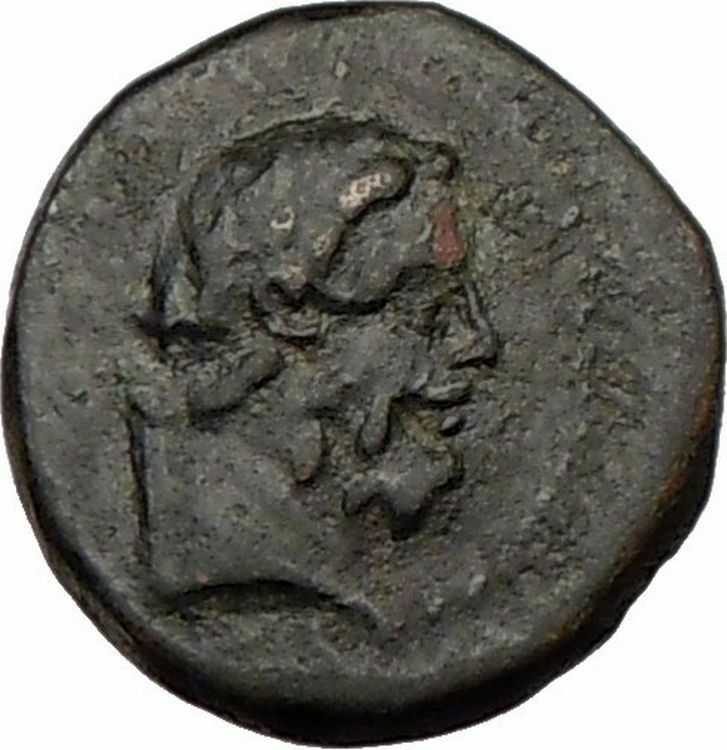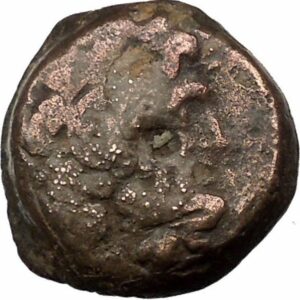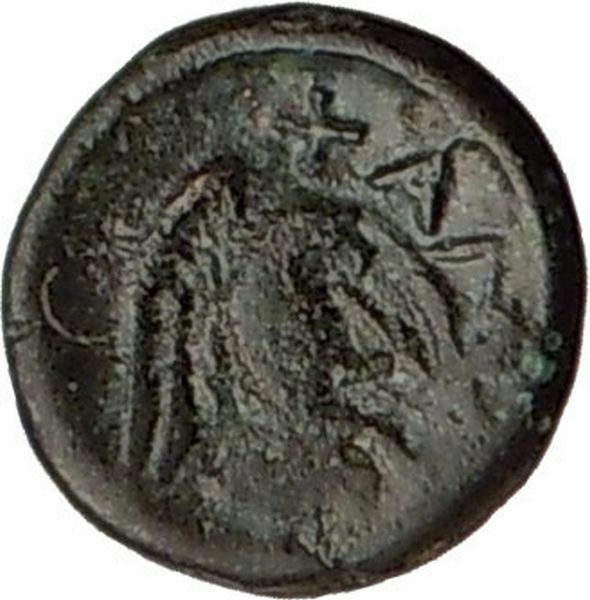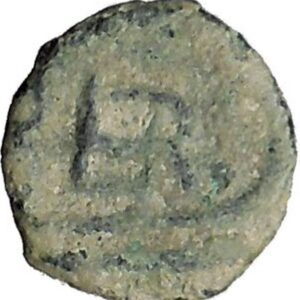|
Item: i47596


Authentic
Ancient Coin of:
Greek city of Pelinna in
Thessaly
Bronze 17mm (4.16 grams) Struck 306-197 B.C.
Reference: Sear 2167; Rogers 433; SNG Copenhagen 191
Veiled head of Mantho right.
Horseman riding right, holding couched lance;
monogram below.
Pelinna (Latin:
Pelinnseum) was an
ancient Greek
city
with a
celebrated
temple
of
Zeus
Pelinnaeus,
in Estiaeotis,
ancient Thessaly
.
Pelinna was situated between
Tricca
and
Pharcadon
, near
modern Palaiogardiki (Trikala
prefecture). The city gained particular
prominence in the fourth century BC through its
alliance with
Philip II of Macedon
.
Among other archaeological evidence of the religious
significance of Pelinna are two
Orphic
gold tablets
(lamellae)
found in 1985 on the site of Petroporos, dating to
the late 4th century BC
You
are bidding on the exact item pictured, provided
with a Certificate of Authenticity and Lifetime
Guarantee of Authenticity.
Thessaly is a traditional
geographical region
and an
administrative region
of
Greece
, comprising
most of the
ancient region
of
the same name. Before the
Greek Dark Ages
,
Thessaly was known as Aeolia, and appears
thus in
Homer
‘s
Odyssey
.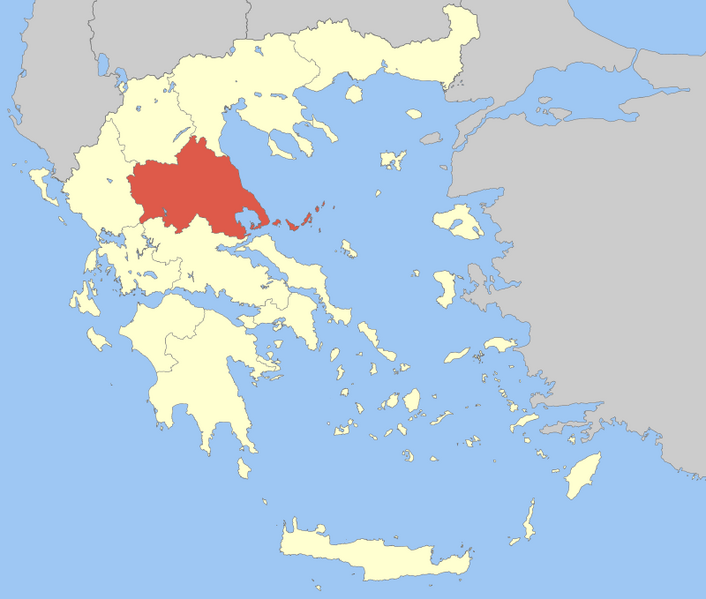
Thessaly became part of the
modern Greek state
in 1881, after four and a half centuries of
Ottoman
rule. Since
1987 it has formed one of the country’s 13
regions
and is
further (since the
Kallikratis reform
of 2010) sub-divided into 5
regional units
and
25
municipalities
. The
capital of the region is
Larissa
. Thessaly
lies in central Greece and borders the regions of
Macedonia
on the
north,
Epirus
on the west,
Central Greece
on
the south and the
Aegean Sea
on the
east. The Thessaly region also includes the
Sporades
islands.
History
Ancient history
Thessaly was home to an extensive
Neolithic
culture
around
2500 BC
.
Mycenaean
settlements have also been discovered, for example
at the sites of
Iolcos
,
Dimini
and
Sesklo
(near
Volos
). In Archaic
and
Classical
times,
the lowlands of Thessaly became the home of baronial
families, such as the
Aleuadae
of
Larissa
or the
Scopads of Crannon. In the 4th century BC
Jason of Pherae
transformed the region into a significant military
power, recalling the glory of Early Archaic times.
Shortly after
Philip II of Macedon
was appointed Archon of Thessaly, and
Thessaly was thereafter associated with the
Macedonian Kingdom for the next centuries. Thessaly
later became part of the
Roman Empire
as
part of the province of
Macedonia
. The
region of Thessaly in the 7th century, experienced
an influx of
Slavic
warlords,
Perboundos
the
Slavic king who established permanent settlement in
Macedonia
also
included Thessaly, as part of his Slavic realm and
region. He named the region “Belzetia” and appointed
a lord to govern and peacefully maintain order. The
Slavic
Belegezites
tribes,
under king Perboundos began building settlements and
agricultural farms known as
subsistance communal farms
.
The lord of Thessaly
Akamir
was at war
with the
Roman Empire
, and
by 700 AD a fortress was fully built. The Slavs of
Macedonia had included Thessaly as part of
Sklavinia
, the
Battle of Larissa
occurred in 780 AD.
Medieval and Ottoman Thessaly
Thessaly remained part of the East Roman
“Byzantine” Empire after the collapse of Roman power
in the west, and subsequently suffered many
invasions, such as by the Slavic tribe of the
Belegezites
in the
7th century AD. Following the campaigns of the
Byzantine general
Staurakios
in
782-783, the Byzantine Empire recovered Thessaly
(then known as
Hellas
), taking
many Slavs as prisoners.[4]
In 977 it was raided by the Bulgarians.
Dissatisfaction about the taxation policy led in
1066 the Aromanian and Bulgarian population of
Thessaly to revolt against the Byzantine Empire
under the leadership of a local lord,
Nikoulitzas Delphinas
.[5]
The revolt, which began in
Larissa
, was soon
expanded in
Trikala
and later
northwards to the Byzantine-Bulgarian border. In
1199-1201 another unsuccessful revolt was led by
Manuel Kamytzes
,
son-in-law of Byzantine emperor
Alexios III Angelos
.[6]
In 1204 it was assigned to
Boniface of Montferrat
and in 1225 to
Theodore Komnenos Doukas
,
despot of
Epirus
. From 1271
to 1318 it was an independent despotate that
extended to
Acarnania
and
Aetolia
, run by
John I Doukas
. In
1309 settled there the
Almogavars
or
Catalan Company
of
the East (Societas Catalanorum Magna), which in
1310, after lifting the siege of Thessalonica,
withdrew as mercenaries in the pay of the
sebastokrator
John II Doukas
, and
took over the country organized in a democracy. From
there they departed to the
Duchy of Athens
,
called by the duke
Walter I
. In 1318,
with the extinction of the
Angelid
dynasty,
the Almogavars occupied Siderokastron and southern
Thessaly (1319) and formed the
duchy of Neopatria
.

One of the flags used in Thessaly during
the
Greek War of
Independence
(designed by
Anthimos Gazis
).
In 1348, it was invaded and occupied by the
Serbs
under
Preljub
. After the
latter’s death in 1356, the region was conquered by
Nikephoros Orsini
,
and after his death three years later, it was taken
over by the self-proclaimed Serbian emperor
Simeon Uroš
.
Simeon’s son
John Uroš
succeeded
in 1370 but abdicated in 1373, and Thessaly was
administered by the Greek Angeloi-Philanthropenoi
clan until the
Ottoman
conquest c.
1393. Ottoman control was disputed by the Byzantines
until the 1420s, when it was consolidated by
Turahan Bey
, who
settled
Turkomans
in the
province and founded the town of
Tyrnavos
.
In 1821, parts of Thessaly and
Magnesia
participated in the initial uprisings in the
Greek War of Independence
,
but these revolts were swiftly crushed. Thessaly
became part of the modern Greek state in 1881, after
the
Treaty of Berlin
.
Geography

Volos
view from
Pelion
mountain.
Thessaly occupies the east side of the
Pindus
watershed,
extending south of Macedonia to the
Aegean Sea
. The
northern tier of Thessaly is defined by a generally
southwest-northeast spur of the Pindus range that
includes
Mount Olympus
,
close to the Macedonian border. Within that broken
spur of mountains are several basins and river
valleys. The easternmost extremity of the spur
extends southeastward from Mt. Olympus along the
Aegean coast, terminating in the
Magnesia
Peninsula
that envelops the
Pagasetic Gulf
(also called the Gulf of Volos), and forms an inlet
of the Aegean Sea. Thessaly’s major river, the
Pineios
, flows
eastward from the central Pindus Range just south of
the spur, emptying into the
Thermaic Gulf
.
The
Trikala
and
Larissa
lowlands
form a central plain which is surrounded by ring of
mountains. It has a distinct summer and winter
season, with summer rains augmenting the fertility
of the plains. This has led to Thessaly occasionally
being called the “breadbasket of Greece”.
The region is well delineated by topographical
boundaries. The
Chasia
and
Kamvounia
mountains
lie to the north, the Mt. Olympus massif to the
northeast. To the west lies the Pindus mountain
range, to the southeast the coastal mountains of
Óssa
and
Pelion
.
Several tributaries of the Pineios flow through
the region.
Demographics
According to the census conducted by ESYE in
2011, the population of the region of Thessaly is
732,762 and represents 6.8% of the total population
of the country.
It has noted a 2.8% decrease in the population
since 2001 and remains the third largest region in
the country population-wise.
The population break-down is 44% urban, 40%
agrarian and 16% semi-urban with the agrarian
population having noted a decline which has been
paralleled with an increase in the semi-urban.
The metropolitan area of Larissa, the capital of
Thessaly, is home to more than 230,000 people,
making it the biggest city of the region.
Major communities

Litheos river flowing through city of
Trikala
.
Economy
The alluvial soils of the
Pineios
Basin and
its tributaries make Thessaly a vital agricultural
area, particularly for the production of
grain
,
cattle
, and
sheep
.
Modernization of agricultural practices in the
mid-20th century has controlled the chronic flooding
that had restricted agricultural expansion and
diversification in the low-lying plains. Thessaly is
the leading cattle-raising area of
Greece
, and
Vlach
shepherds
shift large flocks of
sheep
and
goats
seasonally
between higher and lower elevations. The last
decades, there is a rise in cultivating dried nuts
such as
almonds
,
pistachios
and
walnuts
especially
in the region of
Almyros
. Rise in
the number of olive oil trees have been also
observed. The nearly landlocked
Gulf of Pagasai
provides a natural harbor at
Volos
for shipping
the agricultural products from the plains just to
the west and chromium from the mountains of
Thessaly.
Transport
There are a number of highways
E75
and the main
railway from
Athens
to
Thessaloniki
(Salonika)
crosses Thessaly. The region is directly linked to
the rest of Europe through
International Airport of
Central Greece
located in
Nea Anchialos
in a
small distance from
Volos
and
Larisa
. Until today
charter
flights
links the region and brings tourists to the wider
area, mainly in
Pelion
and
Meteora
. The new
infrastructure includes a brand new terminal ready
to serve 1500 passengers per hour and new airlanes.
Administration
The Thessaly region was established in the 1987
administrative reform. In everyday use, “Thessaly”
is identified with the administrative region,
although the historical region extended south into
Phthiotis
and at
times north into
West Macedonia
as
well.
With the 2010
Kallikratis plan
,
the powers and authority of the region were
redefined and extended. Along with
Central Greece
, it
is supervised by the Decentralized Administration of
Thessaly and Central Greece, based at
Larissa
. The region
is based at
Larissa
and is
divided into five
regional units
(four were pre-Kallikratis
prefectures
),
Karditsa
,
Larissa
,
Magnesia
, the
Sporades
and
Trikala
, which are
further subdivided into 25
municipalities
.
The region’s governor is, since 1 January 2011,
Konstantinos Agorastos
,
who was elected in the
November 2010 local
administration elections
for the
New Democracy
party.
Mythology
In
Homer
‘s epic, the
Odyssey
,
Odysseus
visits the
kingdom of Aeolus, and this is the old name for
Thessaly.
The Plain of Thessaly, which lies between
Mount Oeta
/Othrys
and
Mount Olympus
, is
the site of the
battle
between the
Titans
and the
Olympians
.
According to legend,
Jason
and the
Argonauts
launched
their search for the Golden Fleece from the Magnesia
Peninsula.
A veil is an article of clothing or cloth
hanging that is intended to cover some part of the
head
or
face
, or an object
of some significance. It is especially associated
with women and sacred objects.
One view is that as a religious item, it is
intended to show honor to an object or space. The
actual sociocultural, psychological, and sociosexual
functions of veils have not been studied extensively
but most likely include the maintenance of social
distance and the communication of social status and
cultural identity. In Islamic society, various forms
of the veil have been adopted from the Arab culture
in which Islam arose. The
Quran
has no
requirement that women cover their faces with a
veil, or cover their bodies with the full-body
burqua
or
chador
.

History
The first recorded instance of veiling for women
is recorded in an
Assyrian
legal text
from the 13th century BC, which restricted its use
to noble women and forbade prostitutes and common
women from adopting it.[citation
needed] The
Mycenaean Greek
term a-pu-ko-wo-ko meaning “craftsman of
horse veil” written in
Linear B
syllabic
script is also attested since ca. 1300 BC. In
ancient Greek
the
word for veil was “καλύπτρα” (kaluptra,
Ionic Greek
“καλύπτρη” – kaluptrē, from the verb
“καλύπτω” – kaluptō, “I cover”) and is first
attested in the works of
Homer
.
Classical Greek and Hellenistic statues sometimes
depict Greek women with both their head and face
covered by a veil. Caroline Galt and Lloyd
Llewellyn-Jones have both argued from such
representations and literary references that it was
commonplace for women (at least those of higher
status) in ancient Greece to cover their hair and
face in public.
For many centuries, until around 1175,
Anglo-Saxon
and
then
Anglo-Norman
women,
with the exception of young unmarried girls, wore
veils that entirely covered their hair, and often
their necks up to their chins (see
wimple
). Only in
the
Tudor period
(1485), when
hoods
became
increasingly popular, did veils of this type become
less common.
For centuries, women have worn sheer veils, but
only under certain circumstances. Sometimes a veil
of this type was draped over and pinned to the
bonnet
or hat of a
woman in
mourning
,
especially at the
funeral
and during
the subsequent period of “high mourning”. They would
also have been used, as an alternative to a
mask
, as a simple
method of hiding the identity of a woman who was
traveling to meet a lover, or doing anything she
didn’t want other people to find out about. More
pragmatically, veils were also sometimes worn to
protect the complexion from sun and wind damage
(when un-tanned skin was fashionable), or to keep
dust out of a woman’s face, much as the
keffiyeh
is used
today.
Religion
In
Judaism
,
Christianity
and
Islam
the concept
of covering the head is or was associated with
propriety and modesty. Most traditional depictions
of the
Virgin Mary
, the
mother of
Christ
, show her
veiled. During the
Middle Ages
most
European and Byzantine married women covered their
hair rather than their face, with a variety of
styles of
wimple
, kerchiefs
and headscarfs. Veiling, covering the hair rather
than the face, was a common practice with
church-going women until the 1960s, typically using
lace
, and a number
of very traditional churches retain the custom. Lace
face-veils are still often worn by female relatives
at funerals.
In North India, Hindu women may often veil for
traditional purposes, it is often the custom in
rural areas to veil in front of male elders. This
veil is called the
Ghoonghat
or Laaj.
This is to show humility and respect to those elder
to the woman, in particular elder males. The
ghoonghat is customary especially in the westerly
states of
Gujarat
and
Rajasthan
.
Although religion stands as a commonly held
reason for choosing to veil, it has also reflects on
political regimes and personal conviction, allowing
it to serve as a medium through which personal
character can be revealed.

Praying Jewish woman wearing
Tichel
Judaism
After the
destruction of the Temple
in
Jerusalem
, the
synagogues
that
were established took the design of the
Tabernacle
as their
plan. The
Ark of the Law
,
which contains the
scrolls
of the
Torah
, is covered
with an embroidered curtain or veil called a
parokhet
. (See
also
below
regarding the
veiling – and unveiling – of the bride.)
The
Veil of our Lady
is a liturgical feast celebrating the protection
afforded by the
intercessions
of
the Virgin Mary.
Traditionally, in Christianity, women were
enjoined to cover their heads in church, just as it
was (and still is) customary for men to remove their
hat as a sign of respect. This practice is based on
1 Corinthians 11:4–16
,
where
St. Paul
writes:
Any man who prays or prophesies with his head
covered brings shame upon his head. But any
woman who prays or prophesies with her head
unveiled brings shame upon her head, for it is
one and the same thing as if she had had her
head shaved. For if a woman does not have her
head veiled, she may as well have her hair cut
off. But if it is shameful for a woman to have
her hair cut off or her head shaved, then she
should wear a veil. A man, on the other hand,
should not cover his head, because he is the
image and glory of God, but woman is the glory
of man. For man did not come from woman, but
woman from man; nor was man created for woman,
but woman for man; for this reason a woman
should have a sign of authority on her head,
because of the angels. Woman is not independent
of man or man of woman in the Lord. For just as
woman came from man, so man is born of woman;
but all things are from God. Judge for
yourselves: is it proper for a woman to pray to
God with her head unveiled? Does not nature
itself teach you that if a man wears his hair
long it is a disgrace to him, whereas if a woman
has long hair it is her glory, because long hair
has been given (her) for a covering? But if
anyone is inclined to be argumentative, we do
not have such a custom, nor do the churches of
God (New
American Bible translation)
In many traditional
Eastern Orthodox Churches
,
and in some very conservative
Protestant
churches
as well, the custom continues of women covering
their heads in church (or even when praying
privately at home).
In the
Roman Catholic Church
,
it was customary in most places before the 1960s for
women to wear a headcovering in the form of a scarf,
cap, veil or hat when entering a church. The
practice now continues where it is seen as a matter
of etiquette, courtesy, tradition or fashionable
elegance rather than strictly of canon law.
Traditionalist Catholics
also maintain the practice.
The wearing of a headcovering was for the first
time mandated as a universal rule for the
Latin Rite
by the
Code of Canon Law of 1917
,
which code was abrogated by the advent of the
present (1983) Code of Canon Law. Traditionalist
Catholics majorly still follow it, generally as a
matter of ancient custom and biblically approved
aptness, some also supposing St. Paul’s directive in
full force today as an ordinance of its own right,
without a canon law rule enforcing it. The
photograph here of Mass in the
Netherlands
in
about 1946, two decades before the changes that
followed the
Second Vatican Council
,
shows that, even at that time, when a hat was still
considered part of formal dress for both women and
men, wearing a headcovering at Mass was not a
universal practice for Catholic women.
A veil over the hair rather than the face forms
part of the headdress of some
religiouss
of
nuns
or
religious
sisters;
this is why a woman who becomes a nun is said “to
take the veil”. In medieval times married women
normally covered their hair outside the house, and
nun’s veils are based on secular medieval styles,
reflecting nuns position as “brides of Christ”. In
many institutes, a white veil is used as the “veil
of probation” during
novitiate
, and a
dark veil for the “veil of profession” once
religious vows are taken – the color scheme varies
with the color scheme of the habit of the order. A
veil of
consecration
,
longer and fuller, is used by some orders for final
profession of
solemn vows
.
Nuns are the female counterparts of
monks
, and many
monastic orders
of
women have retained the veil. Regarding other
institutes of religious sisters who are not
cloistered
but who
work as teachers, nurses or in other “active”
apostolates outside of a nunnery or monastery, some
wear the veil, while some others have abolished the
use of the veil, a few never had a veil to start
with, but used a bonnet-style headdress even a
century ago, as in the case of
St. Elizabeth Ann Seton
.
The fullest versions of the nun’s veil cover the
top of the head and flow down around and over the
shoulders. In Western Christianity, it does not wrap
around the neck or face. In those orders that retain
one, the starched white covering about the face neck
and shoulders is known as a
wimple
and is a
separate garment.
The Catholic Church has revived the ancient
practice of allowing women to profess a solemn vow
as
consecrated virgins
.
These women are set aside as sacred persons who
belong only to Christ and the service of the church.
They are under the direct care of the local
bishop
, without
belonging to a particular order and receive the veil
as a
sign
of
consecration
.
There has also been renewed interest in the last
half century in the ancient practice of women and
men dedicating themselves as
anchorites
or
hermits
, and there
is a formal process whereby such persons can seek
recognition of their vows by the local bishop – a
veil for these women would also be traditional.
Some
Anglican
women’s
religious orders also wear a veil, differing
according to the traditions of each order.
In
Eastern Orthodoxy
and in the
Eastern Rites
of
the Catholic Church, a veil called an
epanokamelavkion
is used by both nuns and monks, in both cases
covering completely the
kamilavkion
, a
cylindrical hat they both wear. In
Slavic
practice,
when the veil is worn over the hat, the entire
headdress
is
referred to as a
klobuk
. Nuns
wear an additional veil under the klobuk,
called an
apostolnik
,
which is drawn together to cover the neck and
shoulders as well as their heads, leaving the face
itself open.
Islam
A variety of headdresses worn by
Muslim women
and
girls in accordance with
hijab
(the
principle of dressing modestly) are sometimes
referred to as veils. The principal aim of the
Muslim veil is to hide that which men find sexually
attractive. Many of these garments cover the hair,
ears and throat, but do not cover the face. The
khimar
is a
type of
headscarf
. The
niqāb
and
burqa
are two
kinds of veils that cover most of the face except
for a slit or hole for the eyes.
The
Afghan
burqa covers
the entire body, obscuring the face completely,
except for a grille or netting over the eyes to
allow the wearer to see. The
boshiya
is a
veil that may be worn over a headscarf; it covers
the entire face and is made of a sheer fabric so the
wearer is able to see through it. It has been
suggested that
the practice of wearing a veil
–
uncommon among the
Arab
tribes prior
to the rise of
Islam
– originated
in the
Byzantine Empire
,
and then spread.
The wearing of head and especially face coverings
by Muslim women has raised political issues in the
West; see for example
Hijab controversy in Quebec
,
Islamic dress controversy in
Europe
,
Islamic scarf controversy in
France
, and
United Kingdom debate over
veils
. There is also high debate of the
veil in
Turkey
, a
Muslim majority country
but secular, which banned the headscarves in
universities and government buildings, due to the
türban (a Turkish styled headscarf) being viewed as
a political symbol of Islam
,
see
Headscarf controversy in
Turkey
.

Frances Perkins
wearing a veil after the death of U.S.
President
Franklin D.
Roosevelt
Hats
Veils pinned to hats have survived the changing
fashions of the centuries and are still common today
on formal occasions that require women to wear a
hat. However, these veils are generally made of
netting or another material not actually designed to
hide the face from view, even if the veil can be
pulled down.
Wedding veils
An occasion on which a Western woman is likely to
wear a veil is on her
white wedding
day.
Brides
once used to
wear their hair flowing down their back at their
wedding to symbolise their virginity. Veils covering
the hair and face became a symbolic reference to the
virginity of the bride thereafter. Often in modern
weddings, the ceremony of removing a face veil after
the wedding to present the groom with a virgin bride
is skipped, since many couples have already entered
into conjugal relations prior to their wedding day –
the bride either wears no face veil, or it is lifted
before the ceremony begins, but this is not always
the case. Further, if a bride is a virgin, she often
wears the face veil through the ceremony, and then
either her father lifts the veil, presenting the
bride to her groom, or the groom lifts the veil to
symbolically consummate the marriage, which will
later become literal. Brides who are virgins may
make use of the veil to symbolize and emphasize
their status of purity during their wedding however,
and if they do, the lifting of the veil may be
ceremonially recognized as the crowning event of the
wedding, when the beauty of the bride is finally
revealed to the groom and the guests. It is not
altogether clear that the wedding veil is a
non-religious use of this item, since weddings have
almost always had religious underpinnings,
especially in the West. Veils, however, had been
used in the West for weddings long before this.
Roman brides, for instance, wore an intensely
flame-colored and fulsome veil, called the
flammeum, apparently intended to protect the
bride from
evil spirits
on her
wedding day. Later, the so-called velatio virginum
became part of the rite of the
consecration of virgins
,
the liturgical rite in which the church sets aside
the virgin as a sacred person who belongs only to
Christ.
In the 19th century, wedding veils came to
symbolize the woman’s
virginity
and
modesty
. The
tradition of a veiled bride’s face continues even
today wherein, a virgin bride, especially in
Christian or Jewish culture, enters the marriage
ritual with a veiled face and head, and remains
fully veiled, both head and face, until the ceremony
concludes. After the full conclusion of the wedding
ceremony, either the bride’s father lifts the veil
giving the bride to the groom who then kisses her,
or the new groom lifts her face veil in order to
kiss her, which symbolizes the groom’s right to
enter into conjugal relations with his bride.
The lifting of the veil was often a part of
ancient wedding ritual, symbolizing the
groom
taking
possession of the wife, either as lover or as
property, or the revelation of the bride by her
parents to the groom for his approval.
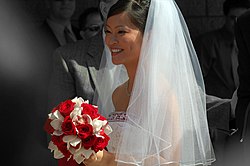
A bride wearing a typical wedding veil
In Judaism, the tradition of wearing a veil dates
back to biblical times. According to the Torah in
Genesis 24:65
,
Isaac is brought Rebekah to marry by his father
Abraham’s servant. It is important to note that
Rebekah did not veil herself when traveling with her
lady attendants and Abraham’s servant and his men to
meet Isaac, but she only did so when Isaac was
approaching. Just before the wedding ceremony the
badeken
or bedeken
is held. The groom places the veil over the bride’s
face, and either he or the officiating Rabbi gives
her a blessing. The veil stays on her face until
just before the end of the wedding ceremony – when
they are legally married according to Jewish law –
then the groom helps lift the veil from off her
face.
The most often cited interpretation for the
badeken
is that,
according to
Genesis 29
, when
Jacob went to marry Rachel, his father in law Laban
tricked him into marrying Leah, Rachel’s older and
homlier sister. Many say that the veiling ceremony
takes place to make sure that the groom is marrying
the right bride. Some say that as the groom places
the veil over his bride, he makes an implicit
promise to clothe and protect her. Finally, by
covering her face, the groom recognizes that he his
marrying the bride for her inner beauty; while looks
will fade with time, his love will be everlasting.
In some ultra-orthodox traditions the bride wears an
opaque veil as she is escorted down the aisle to
meet her groom. This shows her complete willingness
to enter into the marriage and her absolute trust
that she is marrying the right man. In Judaism, a
wedding is not considered valid unless the bride
willingly consents to it.
In ancient
Judaism
the lifting
of the veil took place just prior to the
consummation of the marriage in sexual union. The
uncovering or unveiling that takes place in the
wedding ceremony
is
a symbol of what will take place in the marriage
bed. Just as the two become one through their words
spoken in wedding vows, so these words are a sign of
the physical oneness that they will consummate later
on. The lifting of the veil is a symbol and an
anticipation of this.
In the
Western world
,
St. Paul’s
words
concerning how marriage symbolizes the union of
Christ and His Church may underlie part of the
tradition of veiling in the marriage ceremony.
Dance
Veils are part of the stereotypical images of
courtesans and harem women. Here, the mysterious
veil hints at sensuality, an example being the dance
of the seven veils. This is the context into which
belly dancing veils fall, with a large repertoire of
ways to wear and hold the veil, framing the body and
accentuating movements. Dancing veils can be as
small as a scarf or two, silk veils mounted on fans,
a half circle, three-quarter circle, full circle, a
rectangle up to four feet long, and as large as huge
Isis wings with sticks for extensions. There is also
a giant canopy type veil used by a group of dancers.
Veils are made of rayon, silk, polyester, mylar and
other fabrics (never wool, though). Rarely used in
Egyptian cabaret style, veil dancing has always
played an important part in the international world
of belly dance, extending the range of the dance and
offering lovely transitory imagery.
Courtesans
Conversely, veils are often part of the
stereotypical image of the
courtesan
and
harem
woman. Here,
rather than the virginity of the bride’s veil,
modesty of the Muslim scarf or the piety of the
nun’s headdress, the mysterious veil hints at
sensuality and the unknown. An example of the veil’s
erotic potential is the
dance of the seven veils
.
In this context, the term may refer to a piece of
sheer cloth approximately 3 x 1.5 metres, sometimes
trimmed with sequins or coins, which is used in
various styles of
belly dancing
. A
large repertoire of ways to wear and hold the veil
exists, many of which are intended to frame the body
from the perspective of the audience.
Veils for men
Among the
Tuareg
,
Songhai
,
Moors
,
Hausa
. and
Fulani
of
West Africa
, women
do not traditionally wear the veil, while men do.
The men’s facial covering originates from the belief
that such action wards off evil spirits, but most
probably relates to protection against the harsh
desert sands as well; in any event, it is a firmly
established tradition. Men begin wearing a veil at
age 25 which conceals their entire face excluding
their eyes. This veil is never removed, even in
front of family members.
In
India
,
Pakistan
,
Bangladesh
, and
Nepal
, men wear a
sehra
on their
wedding day. This is a male veil covering the whole
face and neck. The sehra is made from either
flowers, beads, tinsel, dry leaves, or coconuts. The
most common sehra is made from fresh marigolds. The
groom wears this throughout the day concealing his
face even during the wedding ceremony. In India
today you can see the groom arriving on a horse with
the sehra wrapped around his head.
Etymology
“Veil” came from
Latin
vēlum,
which also means “sail“.
There are two theories about the origin of the word
vēlum:-
- Via the “covering” meaning, from (Indo-European
root
) *wel–
= “to cover, to enclose”.
- Via the “sail” meaning, from Indo-European *weghslom,
from root *wegh- = “way” or “carry in a
vehicle”, because it makes the ship move.
|














